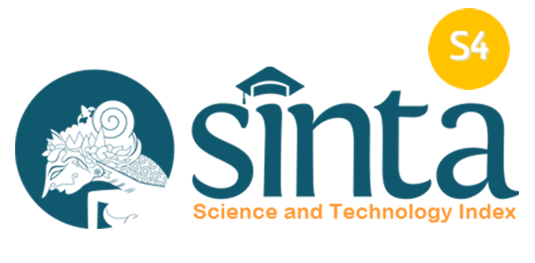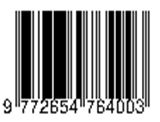KARAKTERISASI FTIR DAN UJI TOKSISITAS HIDROKSIAPATIT NANOKRISTALIN Corbicula moltkiana TERHADAP SEL HUMAN DERMAL FIBROBLAS ADULT
Abstract
Keywords
Full Text:
PDF (Bahasa Indonesia)References
Dala, Y. N. (2018). Sintesis Dan Karakterisasi Hidroksiapatit (Hap) dari Limbah Cangkang Kerang Lokan (Batissa Violecea L) dengan Metode Basah Presipitasi. Jurnal Dinamika Sains, 2 (1), 69.
Gago, J., & Ngapa, Y. D. (2021). Pemanfaatan Cangkang Telur Ayam sebagai Material Dasar dalam Sintesis Hidroksiapatit dengan Metode Presipitasi Basah. Cakra Kimia (Indonesia E-Journal of Applied Chemistry), 9(1)
Haryoto, Muhtadi, Indrayudha, P., Azizah, T., Suhendi, A., & Haryoto, Muhtadi, Peni Indrayudha, Tanti Azizah, A. S. (2013). Aktivitas Sitotoksik Ekstrak Etanol Tumbuhan Sala (Cynometra ramiflora Linn) terhadap Sel HeLa, T47D dan WiDR. Jurnal Penelitian Saintek, 18, 21–28.
Heravi F, Ramezani M, Poosti M, Hosseini M, Shajiei A, Ahrari F., 2013. In Vitro Cytotoxicity Assessment of an Orthodontic Composite Containing Titanium-dioxide Nano- particles. Journal of Dental Research, Dental Clinics, Dental Prospects. JODDD, 7(4):192-8.doi:10.5681/joddd.
Kavasi, R. M., Coelho, C. C., Platania, V., Quadros, P. A., & Chatzinikolaidou, M. (2021). In vitro Biocompatibility Assessment of Nanohydroxyapatite. Nanomaterials, 11(5), 1-15. https://doi.org/10.3390/
Komala, D., Amin, M. N., & Rahayu, Y. C. (2022). Uji Sitotoksisitas Hidroksiapatit Cangkang Telur Ayam Ras (Gallus gallus) terhadap Sel Fibroblas Ligamen Periodontal Manusia. Stomatognatic-Jurnal Kedokteran Gigi, 19 (1), 49. https://doi.org/ 10.19184/stoma.v19i1.30702
Maryam, S., Effendi, N., & Kasmah, K. (2019). Produksi dan Karakterisasi Gelatin dari Limbah Tulang Ayam dengan Menggunakan Spektrofotometer FTIR (Fourier Transform Infra Red). Majalah Farmaseutik, 15(2), 96. https://doi.org/10.22146/
Nastiti AD, Widyastuti W, Laihad FM. (2015). Bioviabilitas Hidroksiapatit Ekstrak Cangkang Kerang Darah (Anadara granosa) terhadap Sel Punca Mesenkimal sebagai Bahan Graft Tulang. Denta-Jurnal Kedokteran Gigi. 2015;9 (2): 122. https://journal-denta.hangtuah.ac.id/ index.php/jurnal/ article/ view/161/ 134. Vol. 9 (2).
Rahayu, Y. C., Triwahyuni, I. E., Kusumawardani, B., & Sari, D. Y. (2022). The Cytotoxic and Proliferative Activity of Cocoa Pod Husk Extract (Theobroma Cacao L.) on Periodontal Ligament Fibroblasts. ODONTO : Dental Journal, 9(1), 46. https://doi.org/10.30659/odj.9.1.46
Raturandang, R., Wenas, D. R., Mongan, S., & Bujung, C. (2022). Analisis Spektroskopi Ftir untuk Karakterisasi Kimia Fisik Fluida Mata Air Panas di Kawasan Wisata Hutan Pinus Tomohon Sulawesi Utara. Jurnal FisTa : Fisika dan Terapannya, 3(1), 28–33. https://doi.org/10.53682/fista.
Sunarintyas, S. (2012). Karakteristik Toksisitas Hidroksiapatit yang Disintesis dari Kalsit terhadap Rattus Norvegicus. Jurnal Teknosains, 2, 1–7.
Yonatasya, F. D., Prananingrum, W., & Ashrin, M. N. (2019). Pengaruh Bone Graft Senyawa Kalsium Hasil Sintesis Cangkang Kerang Darah (Anadara granosa) dengan Variasi Waktu Sintering terhadap Proliferasi Sel Fibroblas pada Proses Socket Healing. Denta, 13(1), 34-43. https://doi.org/ 10.30649/ denta.v13i1.177
DOI: https://doi.org/10.33854/jbd.v12i1.1814
DOI (PDF (Bahasa Indonesia)): https://doi.org/10.33854/jbd.v12i1.1814.g621
Refbacks
- There are currently no refbacks.
Copyright (c) 2025 Muhammad Shalahuddin Al Majiid

This work is licensed under a Creative Commons Attribution-NonCommercial-ShareAlike 4.0 International License.




